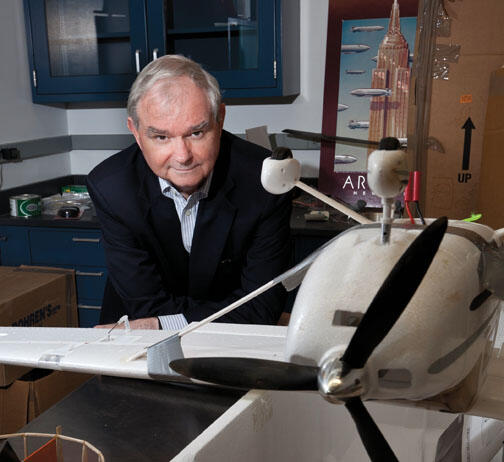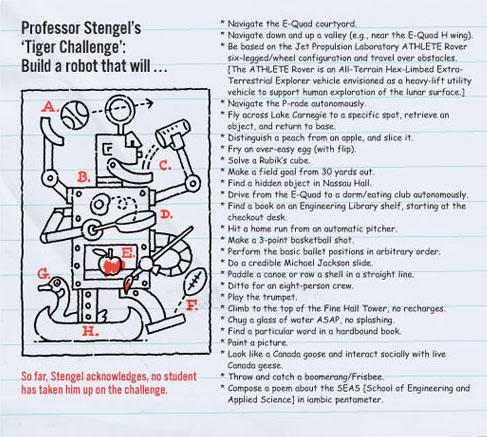
Maybe we have George Lucas to blame — Lucas and all the sci-fi movie directors, novelists, and comic-book writers over the decades who filled us with ideas of what a robot ought to look like. Imagine a robot and you are likely to conjure up a metallic humanoid with an English accent like C-3PO or a rolling tub with flashing lights like R2-D2. Throw in a pair of awkwardly pumping arms like the robot in the old TV series Lost in Space: “Danger, Will Robinson! Danger!”
Truth may be more interesting than fiction, but it doesn’t always look the way you would expect. To see what a real robot looks like, go down to the Engineering Quadrangle and see what they are working on in Professor Robert Stengel’s class, “Robotics and Intelligent Systems.” The class is at the center of the Program in Robotics and Intelligent Design Systems, a certificate program since 1998. Stengel *65 *68 is its first and only director.
Robots, he explains, can come in all shapes and sizes. They can be stationary or mobile, as large as an airplane or small enough to fit in the palm of your hand. And they don’t have to have a tinny, mechanical voice.
What differentiates a robot from other work-doing machines — a sewing machine, for example — is the element of autonomous control. Not only does a robot do things on its own, it contains software that enables it to sense the environment around it and react to what it senses. Robotics combines the design of structural elements with the design of software that enables the machine to interact with the world around it.
Although robotics clubs and competitions have become a high-school staple, the Princeton robotics program is anything but a science-fair project. It is not a competition at
all, although some students have entered their robots in competitions, and there are no predetermined limitations on their budgets or the materials they can use. They are limited only by their imaginations.
Stengel’s course is one of more than a dozen in the robotics program, which spans several departments, including chemical and electrical engineering, civil and environmental engineering, computer science, electric engineering, and mechanical and aerospace engineering. It is open to juniors and seniors who meet several prerequisites for admission: successful completion of lower-level mathematics courses, at least one computer-science course, and either the A.B. science and technology requirement or the B.S.E. freshman science requirement. Although the large majority of students in the program are engineering majors, there have been a few science majors and, for the first time this year, a humanities major.
Students must take three core courses: a lab, a course on control systems, and a course on cognition, language, and decision-making. They also must take three electives, choosing from a roster that includes engineering courses as well as classes in linguistics, psychology, and philosophy. Those non-science courses both broaden the students intellectually and push engineers into new areas of research, Stengel says. Courses in linguistics, for example, are important because they often examine how the brain receives and responds to language — processes scientists try to replicate through artificial-intelligence programs. As Stengel says, “The interactions between people and machines are very interesting to us.”
The highlight of the program, faculty and students agree, is senior independent work. The robotics program website contains several pages of suggested research projects proposed by faculty members. Professor Jeremy Kasdin, for example, has proposed several projects related to his work for NASA’s planet-finding program. Professor Philip Holmes seeks students to assist with research on the mechanics of the way insects move, in order to design legged robots. Professor Wole Soboyejo proposes that students design a device that can pump water in remote villages, asking: “Why not design and make something that could make the world a better place?”
Stengel has proposed a number of research topics of his own, some of which are part of what he has called the Tiger Challenge (see the list, page 32). They challenge students to design a robot that can perform one of several unusual tasks — from kicking a 30-yard field goal to doing the Michael Jackson moon walk to navigating from the E-Quad to one of the eating clubs. All of them are theoretically doable but some, Stengel acknowledges, “are more preposterous than others.” So far, no student has taken Stengel up on any of the challenges on the list.
Robotics is also an extracurricular activity. The Princeton Autonomous Vehicle Engineering (PAVE) group has been working on a number of projects, including perfecting a fully autonomous Ford Escape known as Prospect 12 that can navigate the highways without any human oversight; and Phobetor, a mobile, 270-pound, human-sized robot that can — and did — deliver a fruitcake to a professor.
“It’s one thing to do problem sets and sit in lectures, and another thing to go out and really kick the tires,” says Professor Alain Kornhauser *71, who has served as the faculty adviser for several PAVE projects. Kornhauser’s goal — in addition to addressing real-world problems such as reducing car accidents — is to get Prospect 12 to a point where it could pass the New Jersey driver’s license test, and he believes the students are getting closer.
Students have taken Prospect 12 out in parking lots near the Forrestal Campus, but are always careful to have someone sit behind the wheel just in case something goes wrong and it becomes necessary to override the computer controls. “The car is safer than a lot of drivers,” says Josh Newman ’11, who served as the project manager last year: “It knows its limitations and it never falls asleep.”
Technological innovations are making it possible to explore robotics in ways never before possible. Perhaps the most important is vastly increased computing power. Many years ago, for example, Stengel challenged students to design a robot that could fit inside a one-inch cube. They gave it their best try, but the project required them to possess the technical delicacy of Swiss watchmakers and proved too difficult to execute.
When he posed the challenge again two years ago, students were able to design such a robot three-dimensionally on a computer. “They were able to postulate that it would work without actually making it,” Stengel says. It now may even be possible to make that tiny computer using 3-D printing technology, which can take a computer design and reproduce it in layers of plastic.
Stengel’s own futuristic credentials are unimpeachable. As a Princeton graduate student in the 1960s, he worked in Professor Enoch Durbin’s flight-instrumentation laboratory, learning techniques that he later would use at the Air Force, NASA, and the Charles Stark Draper Laboratory in Cambridge, Mass., where he is credited with designing the manual-control system for the lunar module and the space shuttle. After joining the faculty in 1977, he served as director of the Flight Research Laboratory on the Forrestal Campus, where several innovative electronically controlled aircraft were designed using what was then cutting-edge robotics technology. In today’s robotics program, Stengel sees a rebirth of that innovative spirit.
“The whole notion of integrating computers with things you want to do for humanity is at the heart of these projects,” he says.
The stories of three student projects — all works in progress — are told in the following pages.








1 Response
Anonymous
9 Years AgoBUZZ BOX: Big challenges still await robot designers
Alumni responded to PAW’s Nov. 16 cover story that described Princeton’s Program in Robotics and Intelligent Systems, led by Professor Robert Stengel *65 *68, and profiled three students and the robots they had developed.
“The work is wonderful; and all these people are much smarter than I am,” wrote Bruce Deitrick Price ’63 in a comment posted at PAW Online. “But I have to tell you this: The problem with all articles about robots (besides loose semantics) is that they paint an unrealistic picture of the AI challenge. Everything is moving much slower than once predicted because we are so much more complex than the experts assumed.” Price noted that more of his views on the subject can be found by Googling “17: Understanding Robots.”
James R. Schueler ’66 offered a different perspective: “Considering the present economic situation, what we need now is a robot that will buy a house and a car.”